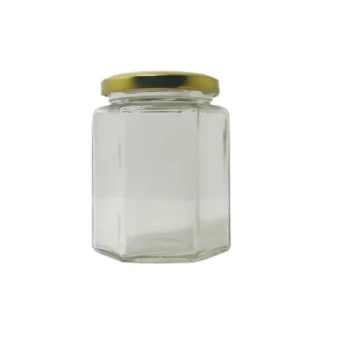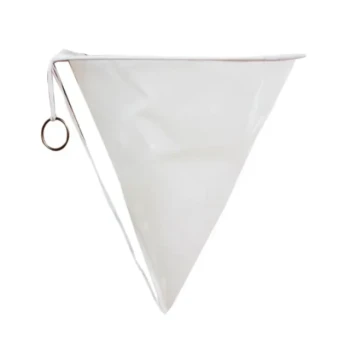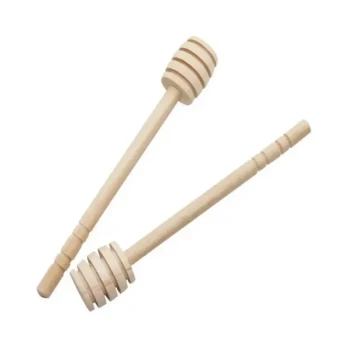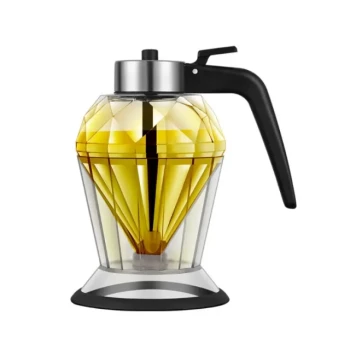For harvesting, processing, and marketing honey, the choice of container depends entirely on the specific stage and scale of your operation. For collection and initial storage, food-grade plastic pails up to 20 kg are standard. For final marketing, containers range from small glass or plastic jars (2-5 kg) and single-use sachets to large 200-liter drums for bulk wholesale distribution.
The most critical factor is not the container's shape or size, but its material. Using only new, certified food-grade materials like specific plastics or glass is non-negotiable to prevent contamination and protect the integrity of your honey.
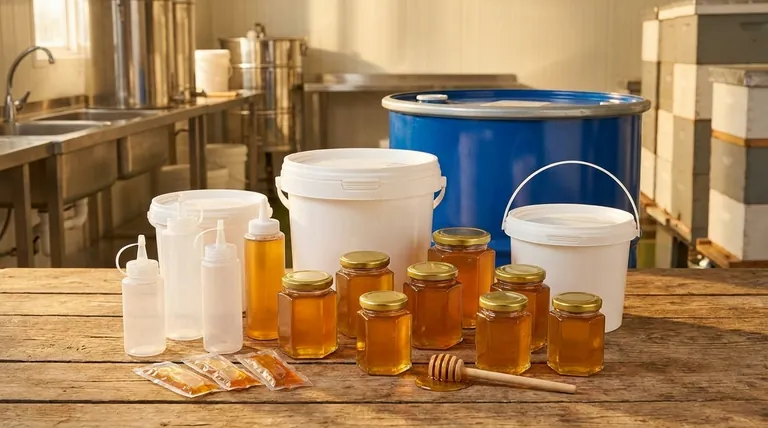
The Core Principle: Food-Grade Integrity
Before considering size or style, you must understand the foundational rule of honey storage. Honey is an acidic food product, and it will interact with the surface it touches.
Why "Food-Grade" is Essential
"Food-grade" means the material has been certified safe for contact with food. It will not leach harmful chemicals, residues, or flavors into the honey.
Using non-food-grade containers, such as standard hardware store buckets, poses a significant risk of contaminating your entire batch with toxins, rendering it unsafe and unsellable.
Approved Materials: Plastic vs. Glass
Food-grade plastic is the workhorse of the honey industry. It is lightweight, durable, and cost-effective. These containers, often made of HDPE (High-Density Polyethylene), are ideal for harvesting and bulk storage.
Glass is the premium choice for retail marketing. It is inert, meaning it will not react with the honey at all, and its clarity showcases the product's quality. While heavier and more fragile, it conveys a high-value perception to the customer.
Containers by Production Stage
Your container needs will change as honey moves from the hive to the shelf.
Stage 1: Harvesting and Collection
During harvest, you need a practical way to transport honeycombs or freshly extracted honey.
Food-grade plastic pails with a capacity of up to 20 kg (approx. 5 gallons) are the industry standard. Their manageable size prevents them from becoming too heavy, and secure, sealable tops are crucial for keeping out dust, insects, and other contaminants.
Stage 2: Processing and Bulk Storage
After extraction and filtering, honey is often stored in larger volumes before it is bottled for sale.
For large-scale beekeepers or cooperatives, 200-liter (55-gallon) drums are used for bulk storage and wholesale. These must also be made of food-grade plastic or lined with a food-safe coating.
Stage 3: Retail Marketing and Packaging
This stage offers the most variety, as the container becomes part of the product's appeal.
- Glass Jars: The classic choice for retail. They are infinitely recyclable and offer a premium look.
- Plastic Jars & Squeeze Bottles: Often made from clear PET plastic, these are a shatterproof and often lower-cost alternative to glass, popular for their convenience.
- Sachets: Small, single-serving plastic packets are ideal for food service applications, samples, or inclusion in gift baskets.
Understanding the Critical Trade-offs
Choosing the wrong container is one of the most common and costly mistakes in honey production.
The Absolute Prohibition of Second-Hand Containers
Never use second-hand containers, even if they previously held food.
Microscopic scratches can harbor bacteria, and residual odors or oils from previous contents (like pickles or sauces) can be absorbed by the honey, ruining its delicate flavor profile. The risk of contamination far outweighs any minor cost savings.
Material Impact on Honey Quality
Beyond safety, the container material can affect the honey itself. Clear containers (both glass and plastic) allow sunlight to pass through.
Prolonged exposure to UV light can degrade the enzymes and darken the color of the honey over time. If honey will be stored for a long period, an opaque container in a dark, cool location is best.
Making the Right Choice for Your Goal
Select your container based on your specific purpose to ensure safety, quality, and marketability.
- If your primary focus is hobbyist harvesting: Use new, food-grade plastic pails (up to 20 kg) with tight-fitting lids for collection and short-term storage.
- If your primary focus is large-scale wholesale: Invest in 200-liter food-grade drums for efficient bulk storage and transport.
- If your primary focus is premium retail sales: Package your honey in classic glass jars to signal high quality to consumers.
- If your primary focus is convenience or food service: Use PET plastic squeeze bottles or single-serving sachets.
Proper container selection is the final, critical step in preserving the quality and safety of your honey from the hive to the table.
Summary Table:
| Production Stage | Recommended Container | Key Characteristics |
|---|---|---|
| Harvesting & Collection | Food-grade plastic pails (up to 20 kg) | Lightweight, durable, sealable lids for contamination control |
| Processing & Bulk Storage | 200-liter food-grade drums | Ideal for large-scale operations and wholesale distribution |
| Retail Marketing | Glass jars, plastic jars, squeeze bottles, sachets | Premium appeal (glass), convenience (plastic), or single-serving use (sachets) |
Ensure the integrity of your honey from hive to market with the right containers. HONESTBEE supplies commercial apiaries and beekeeping equipment distributors with wholesale-focused, certified food-grade honey containers—including durable pails, bulk drums, and retail-ready jars. Protect your product's quality and safety with our reliable solutions. Contact HONESTBEE today to discuss your container needs and request a wholesale quote!
Visual Guide
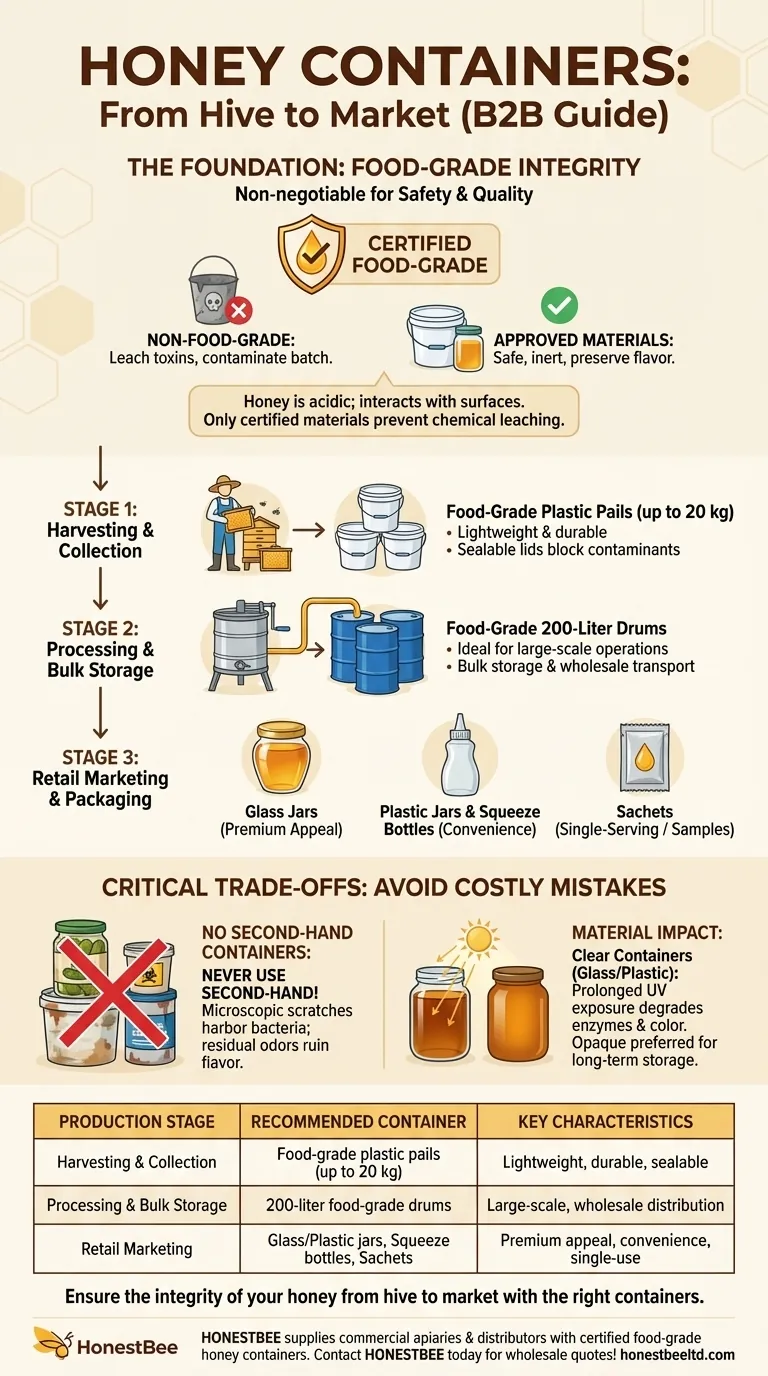
Related Products
- Hexagonal Glass Honey Jars with Metal Lug Caps Elegant Versatile Packaging
- Inverted Squeezable Honey Jar with No Drip Flip Top Cap for Easy Pouring
- Professional Cone-Shaped Honey Filter with Reinforced Steel Ring
- Natural Wood Honey Dipper for Tea Coffee and Desserts
- Premium Diamond-Faceted Glass Honey Dispenser
People Also Ask
- Why is a glass jar preferred for packaging honey? Ultimate Protection for Purity & Flavor
- How many jars of honey do you get from a hive? Unlock Sustainable Harvesting Secrets
- What factors should be considered when choosing honey packaging? Optimize for Brand, Operations & Market
- What are the common types of honey packaging? A Guide to Glass, Plastic, Pouches & Tins
- What is the term for honey can absorb moisture from the air? Understanding Hygroscopy
